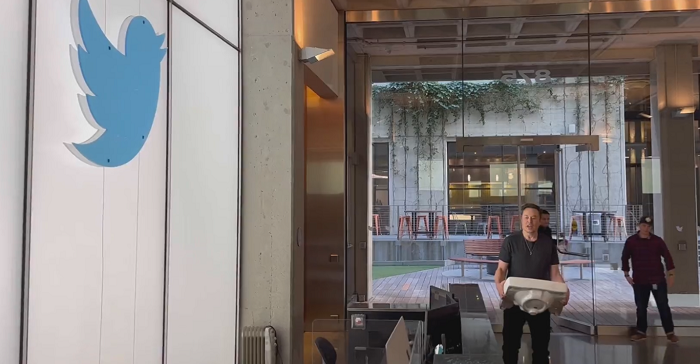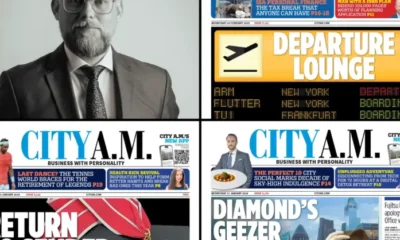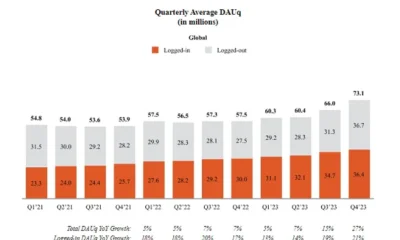SOCIAL
Musk Looks to Reassure Advertisers Ahead of Twitter Takeover, Outlines Elements of His Plan

As he prepares for the next stage of his Twitter takeover, which looks set to be finalized this week, Elon Musk has released a new statement on his intentions for the platform, and the impact that it will have on advertisers, who’ve been justifiably concerned about Musk’s vision for the app.
Because as Musk has said directly:
Musk has said, straight up, that he will look to remove ads from the platform entirely, which would re-shape a lot of marketing approaches at many brands.
But now, after visiting Twitter HQ, and with $44 billion about to be debited from his account, Musk has changed his mind on this.
As per Musk:
“There’s been much speculation about why I bought Twitter, and what I think about advertising. Most of it has been wrong.”
Which, from, the first line, feels a bit revisionist. Musk has also said that he hates advertising, in addition to the above tweet about removing ads from Twitter.
But again, with the clarity of debt, Musk has now switched up, and says that he actually wants to make Twitter ‘the most respected advertising platform in the world’.
“I also very much believe that advertising, when done right, can delight, entertain and inform you; it can show you a service or product or medical treatment that you never knew existed, but is right for you. For this to be true, it’s essential to show Twitter users advertising that is as relevant as possible to their needs. Low relevancy are spam, but high relevancy ads are content.”
Ah, so advertising is okay so long as it’s good. Keep that in mind marketers.
How Musk plans to enforce this, and ensure that Twitter only publishes good, relevant ads is not clear. But rest assured ad partners, Musk’s not going to cut you off from the app – despite his previous and repeated statements that that’s exactly what he would do. That was just speculation, according to Musk. Didn’t come from him.
So goes the usual Elon Musk approach – saying one thing, then completely denying it, and blaming outside forces for misinterpreting his statements.
The same also relates to his recent statement that he’ll look to cut 75% of Twitter staff as soon as he takes over as ‘Chief Twit’ (as per his new Twitter bio).
Yet, after he visited Twitter HQ yesterday, he posted that he’d met ‘a lot of cool people’ at the app.
Yes, he bought a sink with him, for a random and unfunny sight gag. Wacky.
Of course, saying that he met a lot of cool folk doesn’t mean that he won’t sack them. But it does suggest that Musk’s not going to be as militant in his approach as he’s suggested in his previous statements.
So what are his plans then?
To unite the world, apparently:
“The reason I acquired Twitter is because it’s important to the future of civilization to have a common digital town square, where a wide range of beliefs can be debated in a healthy manner, without resorting to violence. There is currently great danger that social media will splinter into far right wing and far left wing echo chambers that generate more hate and divide our society.”
Musk also notes that he ‘didn’t do it to make money’. Which is pretty obvious, since he spent months trying to renege on the deal, and also recently noted that he’s ‘obviously overpaying’ for the app.
That’s another element that Musk is now trying to play down – Musk has spent months criticizing Twitter, its board, its staff, poking holes in its business model, and generally, highlighting why it’s a disastrous investment.
But now? All smiles.
‘In addition to adhering to the laws of the land, our platform must be warm and welcoming to all, where you can choose your desired experience according to your preferences, just as you can choose, for example, to see movies or play video games ranging from all ages to mature.”
Warm and welcoming. That’s definitely not the Twitter vision that Musk has been painting.
But again, the clarity of debt.
The latter reference here relates to Elon’s vision of creating variable algorithms, which users could then choose to apply to their Twitter feed. The concept is interesting, but whether users will actually want to go to the effort of curating their own experience, as opposed to just checking out what the app has on offer, remains to be seen.
And that’s the real rub here. Musk says that he has a plan, and he’s now making statements like these about the future of the app, and how it can be a transformative, uniting experience.
But making that a reality seems like a truly impossible task. And while Musk prides himself on taking on the impossible, this one feels like it could be beyond even his reach.
It feels like, in many ways, Musk will be relying on his public persona to win over users. But do people really like his wacky rich guy shtick?
I don’t know, it’s a massive, and very public task, which could hurt Musk’s reputation, along with his net worth. The general concepts that Musk’s been touting do make sense – user-defined experience, freedom of speech versus freedom of reach, improved algorithmic targeting (ala TikTok), and payments, shopping and more, like WeChat in China.
Musk has pointed to all of these apps and options as reference points for his Twitter vision. But so has every social media app. Meta’s been trying for years to replicate the utility of Chinese messaging apps, every platform’s trying to work out TikTok’s secret sauce, and users already do have a lot of choice regarding what they see in-stream.
The problem is in the application. Western users haven’t warmed to app functionalities in the same way as Chinese consumers have, TikTok’s winning because its algorithms are better and no one can match it, and while users are able to change their feed experience, in various ways, most can’t be bothered, and even if they do, engagement declines as a result
So while Musk is keen to explore these things, each is, indeed, easier said than done.
But it’s Elon Musk, if anyone can do it, he can. Right?
The Musk era is about to begin, and it’ll be fascinating to see how, exactly, he looks to enact any of this.
SOCIAL
Snapchat Explores New Messaging Retention Feature: A Game-Changer or Risky Move?

In a recent announcement, Snapchat revealed a groundbreaking update that challenges its traditional design ethos. The platform is experimenting with an option that allows users to defy the 24-hour auto-delete rule, a feature synonymous with Snapchat’s ephemeral messaging model.
The proposed change aims to introduce a “Never delete” option in messaging retention settings, aligning Snapchat more closely with conventional messaging apps. While this move may blur Snapchat’s distinctive selling point, Snap appears convinced of its necessity.
According to Snap, the decision stems from user feedback and a commitment to innovation based on user needs. The company aims to provide greater flexibility and control over conversations, catering to the preferences of its community.
Currently undergoing trials in select markets, the new feature empowers users to adjust retention settings on a conversation-by-conversation basis. Flexibility remains paramount, with participants able to modify settings within chats and receive in-chat notifications to ensure transparency.
Snapchat underscores that the default auto-delete feature will persist, reinforcing its design philosophy centered on ephemerality. However, with the app gaining traction as a primary messaging platform, the option offers users a means to preserve longer chat histories.
The update marks a pivotal moment for Snapchat, renowned for its disappearing message premise, especially popular among younger demographics. Retaining this focus has been pivotal to Snapchat’s identity, but the shift suggests a broader strategy aimed at diversifying its user base.
This strategy may appeal particularly to older demographics, potentially extending Snapchat’s relevance as users age. By emulating features of conventional messaging platforms, Snapchat seeks to enhance its appeal and broaden its reach.
Yet, the introduction of message retention poses questions about Snapchat’s uniqueness. While addressing user demands, the risk of diluting Snapchat’s distinctiveness looms large.
As Snapchat ventures into uncharted territory, the outcome of this experiment remains uncertain. Will message retention propel Snapchat to new heights, or will it compromise the platform’s uniqueness?
Only time will tell.
SOCIAL
Catering to specific audience boosts your business, says accountant turned coach

While it is tempting to try to appeal to a broad audience, the founder of alcohol-free coaching service Just the Tonic, Sandra Parker, believes the best thing you can do for your business is focus on your niche. Here’s how she did just that.
When running a business, reaching out to as many clients as possible can be tempting. But it also risks making your marketing “too generic,” warns Sandra Parker, the founder of Just The Tonic Coaching.
“From the very start of my business, I knew exactly who I could help and who I couldn’t,” Parker told My Biggest Lessons.
Parker struggled with alcohol dependence as a young professional. Today, her business targets high-achieving individuals who face challenges similar to those she had early in her career.
“I understand their frustrations, I understand their fears, and I understand their coping mechanisms and the stories they’re telling themselves,” Parker said. “Because of that, I’m able to market very effectively, to speak in a language that they understand, and am able to reach them.”Â
“I believe that it’s really important that you know exactly who your customer or your client is, and you target them, and you resist the temptation to make your marketing too generic to try and reach everyone,” she explained.
“If you speak specifically to your target clients, you will reach them, and I believe that’s the way that you’re going to be more successful.
Watch the video for more of Sandra Parker’s biggest lessons.
SOCIAL
Instagram Tests Live-Stream Games to Enhance Engagement

Instagram’s testing out some new options to help spice up your live-streams in the app, with some live broadcasters now able to select a game that they can play with viewers in-stream.
As you can see in these example screens, posted by Ahmed Ghanem, some creators now have the option to play either “This or That”, a question and answer prompt that you can share with your viewers, or “Trivia”, to generate more engagement within your IG live-streams.
That could be a simple way to spark more conversation and interaction, which could then lead into further engagement opportunities from your live audience.
Meta’s been exploring more ways to make live-streaming a bigger consideration for IG creators, with a view to live-streams potentially catching on with more users.
That includes the gradual expansion of its “Stars” live-stream donation program, giving more creators in more regions a means to accept donations from live-stream viewers, while back in December, Instagram also added some new options to make it easier to go live using third-party tools via desktop PCs.
Live streaming has been a major shift in China, where shopping live-streams, in particular, have led to massive opportunities for streaming platforms. They haven’t caught on in the same way in Western regions, but as TikTok and YouTube look to push live-stream adoption, there is still a chance that they will become a much bigger element in future.
Which is why IG is also trying to stay in touch, and add more ways for its creators to engage via streams. Live-stream games is another element within this, which could make this a better community-building, and potentially sales-driving option.
We’ve asked Instagram for more information on this test, and we’ll update this post if/when we hear back.
-

 PPC5 days ago
PPC5 days ago19 Best SEO Tools in 2024 (For Every Use Case)
-
SEARCHENGINES7 days ago
Daily Search Forum Recap: April 17, 2024
-
SEARCHENGINES6 days ago
Daily Search Forum Recap: April 18, 2024
-
SEARCHENGINES5 days ago
Daily Search Forum Recap: April 19, 2024
-

 MARKETING6 days ago
MARKETING6 days agoEcommerce evolution: Blurring the lines between B2B and B2C
-

 SEO6 days ago
SEO6 days ago2024 WordPress Vulnerability Report Shows Errors Sites Keep Making
-

 WORDPRESS5 days ago
WORDPRESS5 days agoHow to Make $5000 of Passive Income Every Month in WordPress
-

 WORDPRESS6 days ago
WORDPRESS6 days ago10 Amazing WordPress Design Resouces – WordPress.com News















You must be logged in to post a comment Login